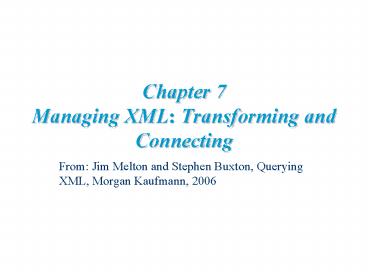Chapter 7 Managing XML: Transforming and Connecting - PowerPoint PPT Presentation
1 / 18
Title:
Chapter 7 Managing XML: Transforming and Connecting
Description:
... other forms, including HTML or plain text, as well as new XML documents. ... Technology intended to help define and strengthen the relationships between two ... – PowerPoint PPT presentation
Number of Views:18
Avg rating:3.0/5.0
Title: Chapter 7 Managing XML: Transforming and Connecting
1
Chapter 7Managing XML Transforming and
Connecting
- From Jim Melton and Stephen Buxton, Querying
XML, Morgan Kaufmann, 2006
2
7.1 Introduction
- XML documents interact in many ways with their
environment. - E.g., they can be transformed from one structure
to a different structure, or they can be
transformed into some user-friendly format such
as HTML or PDF. - They are frequently modularized to place some
information into one physical resource (e.g., a
file) and other information into a different
resource. - They reference one another in various ways, both
simple and complex.
3
7.2 Transforming, Formatting, and Displaying XML
- XML documents are not especially pretty to look
at. - The W3C has created two languages for "reshaping"
documents in various ways. - XSLT. for transforming the content and structure
of XML documents into any of several other forms,
including HTML or plain text, as well as new XML
documents. - XSL-FO provides a mechanism by which XML
documents can be converted into formats suitable
for printing or viewing, such as PostScript and
PDF (or even Microsoft's Rich Text Format, RTF). - This has to do with querying XML.
4
7.2.1 Extensible Stylesheet Language
Transformations
- XSLT 1.0 depends on XPath 1.0 as the language in
which search and matching criteria are expressed
- that is, as its query language. - XSLT 1.0 was one of the driving forces behind the
development of XPath 1.0 and was arguably its
most important "customer." - At the same time that XPath 2.0 and XQuery 1.0
were being developed, a new version of XSLT
(known, naturally, as XSLT 2.0) 4 was being
specified. - The details of XSLT 2.0 differ in significant
ways from those of XSLT 1.0, but the overall
goals and mechanisms remain the same. XSLT 2.0
adds XHTML to the choices of output methods. - XSLT is a functional language without side
effects. - XSLT is a language expressed in XML,
- Namespace prefix "xsl".
5
(No Transcript)
6
(No Transcript)
7
(No Transcript)
8
(No Transcript)
9
(No Transcript)
10
7.2.2 Extensible Stylesheet Language - Formatting
Objects (XSL FO)
- The original mission of the W3C's XSL Working
Group was to define a true stylesheet language
for XML that would serve approximately the same
purpose that CSS (Cascading Style Sheets) serves
for HTML and that DSSSL serves for SGML to
determine the visualdisplay characteristics of
documents on a computer display and/or on paper.
11
7.2.2 Extensible Stylesheet Language - Formatting
Objects (XSL FO)
- The XSL specification defines, like XSLT, a
number of XML elements and attributes that allow
an application to control such formatting
characteristics as page structure, font and size
of text, list element numbering, and image
placement as well as structural characteristics
such as tables, blocks of text (e.g.,
paragraphs), and footnotes. - The elements defined by XSL FO are placed into a
specific namespace, often indicated by the
namespace prefix "fo".
12
(No Transcript)
13
7.3 The Relationships between XML Documents
- Technology intended to help define and strengthen
the relationships between two or more XML
documents.
14
7.3.1 XML Inclusions (Xlnclude)
- Virtually all programmers are familiar with the
ability to modularize program code. - Modularization is a process in which an entity is
broken into several parts that can then be
reassembled into the desired whole. - Documents can be, and frequently are, modularized
in the same manner. - For example, a book typically has multiple
components, such as chapters, appendices, tables,
and figures. - Those components may be written and updated by
different people, at different times, using
different tools. They are all brought together to
form the final book.
15
7.3.1 XML Inclusions (Xlnclude)
16
7.3.1 XML Inclusions (Xlnclude)
- XML Inclusions (XInclude), "introduces a generic
mechanism for merging XML documents."
17
(No Transcript)
18
(No Transcript)































